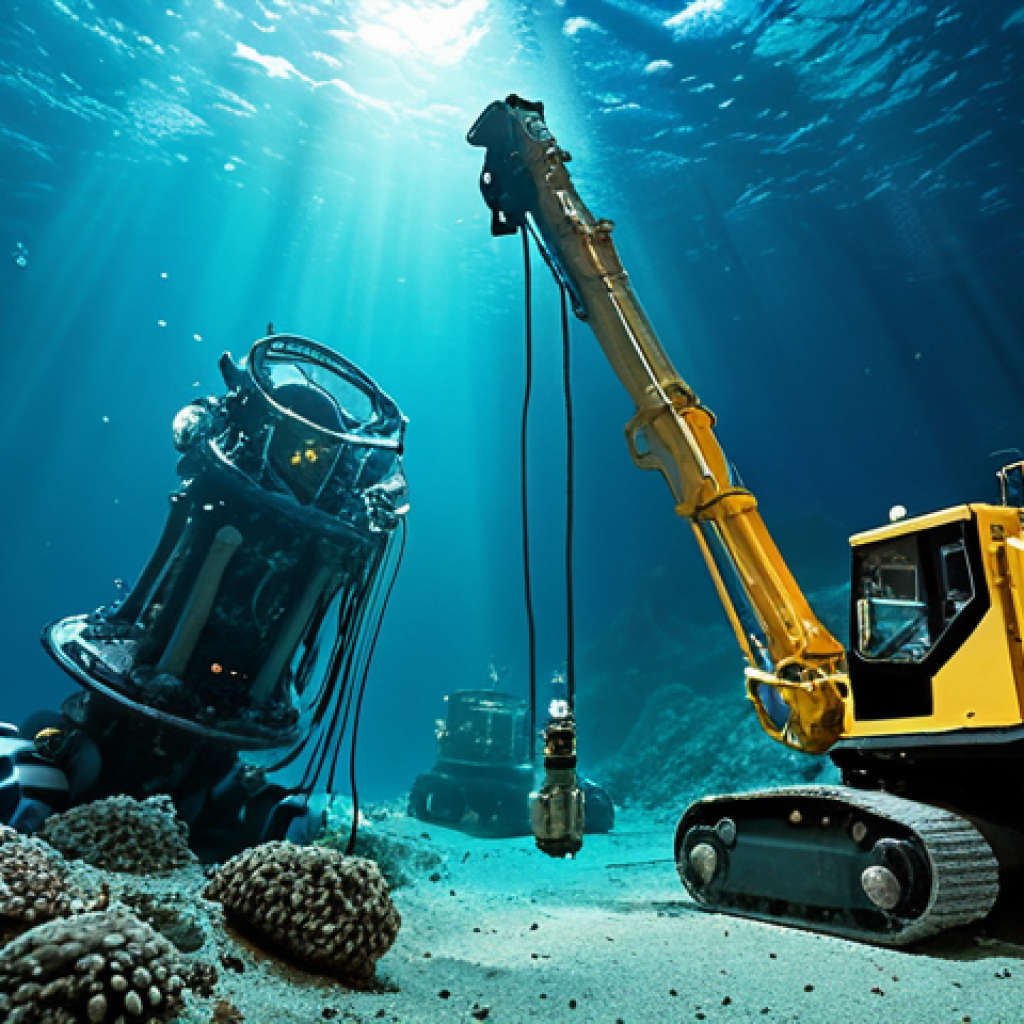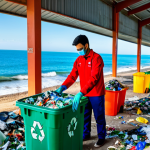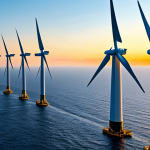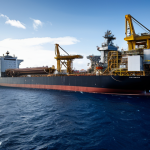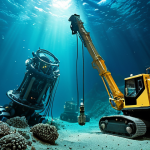Our oceans, vast and mysterious, hold immense potential for resources – from minerals on the seabed to the energy of the tides. But as we eye these treasures, the looming shadow of climate change casts a long and uncertain pall.
Rising sea levels, ocean acidification, and shifting marine ecosystems are not just environmental concerns; they’re direct threats to any sustainable development plan we might envision.
Having witnessed firsthand the changing coastlines during my research trips, I’ve come to realize that responsible exploration is no longer just an option, it’s an absolute necessity.
It’s a balancing act between tapping into the ocean’s wealth and safeguarding its fragile beauty for future generations. Recent discussions at the International Seabed Authority highlight the urgent need for stricter environmental regulations and transparent governance in deep-sea mining.
The future, as some predict, involves innovative technologies like carbon capture and storage integrated with ocean energy farms, but are we truly ready for that leap?
Let’s dive deeper into this complex issue in the following article.
Harnessing the Blue Economy: A Sustainable Path Forward? The “blue economy” is buzzing, promising economic growth fueled by our oceans. We’re talking about everything from offshore wind farms to sustainable aquaculture.
But it’s not as simple as just diving in headfirst. The real challenge is how to tap into these resources responsibly, especially when climate change is already shaking things up.
I recently attended a marine biology conference where this was the hottest topic. The consensus? We need a strategic, thoughtful approach.
Navigating the Murky Waters of Deep-Sea Mining
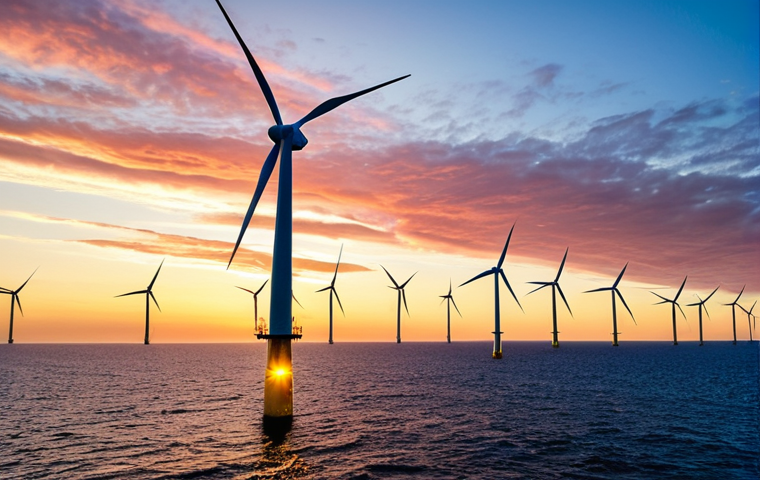
The Allure of Seabed Minerals
The ocean floor is rich in minerals like cobalt, nickel, and manganese – essential components in batteries for electric vehicles and other green technologies.
Sounds great, right? Well, gaining access to these minerals requires deep-sea mining, which involves extracting resources from fragile ecosystems.
Environmental Risks Versus Economic Rewards
The big debate is whether the economic benefits of deep-sea mining outweigh the potential environmental damage. We’re talking about destroying unique habitats, disrupting marine life, and potentially releasing harmful toxins into the water column.
Some researchers argue that the environmental cost is simply too high, while others believe that responsible mining practices can minimize the impact.
The Promise and Peril of Ocean Energy
Harnessing the power of the ocean seems like a no-brainer – endless waves, tides, and thermal gradients. But the technology is still relatively new, and there are significant hurdles to overcome.
I remember visiting a tidal energy project in Scotland and being struck by both its potential and its limitations.
Riding the Wave: Tidal and Wave Energy Technologies
The High Costs of Implementing the New Technologies
Tidal energy, which harnesses the power of tides, is relatively predictable and reliable. Wave energy, on the other hand, is more variable and challenging to capture.
Both technologies require significant investment in infrastructure and can have environmental impacts, such as disrupting marine life and altering coastal habitats.
The Potential of Offshore Wind Farms
Offshore wind farms are becoming increasingly popular, and for good reason. They can generate large amounts of clean energy and are generally less disruptive to the environment than fossil fuel-based power plants.
However, they can also pose risks to marine life, such as birds and marine mammals, and can impact fishing activities.
Sustainable Aquaculture: Feeding the Future Without Draining the Oceans
As land-based agriculture faces increasing pressure from climate change and population growth, sustainable aquaculture is emerging as a potential solution.
But not all aquaculture is created equal.
Finding the Right Balance
The Environmental Costs of Aquaculture
Some aquaculture practices, such as shrimp farming, can have devastating environmental consequences, including habitat destruction, pollution, and the spread of disease.
Sustainable aquaculture practices, on the other hand, focus on minimizing environmental impact and promoting biodiversity. This includes using closed-loop systems, reducing the use of antibiotics, and selecting appropriate locations for farms.
The Impact on Local Fisheries
I met a fisherman in Iceland who shared his concerns about the impact of salmon farms on wild salmon populations. It’s a complex issue, but one thing is clear: we need to find a way to balance the needs of the aquaculture industry with the need to protect wild fish stocks.
Navigating the Climate Change Storm: Resilience and Adaptation Strategies
Climate change is already having a profound impact on our oceans, from rising sea levels to ocean acidification. We need to develop strategies to mitigate these impacts and build resilience into our coastal communities.
Reducing Carbon Emissions
Using Technology to Help Reduce Emissions
The most important thing we can do to protect our oceans is to reduce carbon emissions. This requires a global effort to transition to clean energy sources and improve energy efficiency.
It also requires investing in technologies like carbon capture and storage, which can remove carbon dioxide from the atmosphere.
The Importance of Carbon Sequestration
Ocean-based carbon sequestration strategies, such as restoring mangrove forests and seagrass beds, can also help to remove carbon dioxide from the atmosphere and store it in the ocean.
These strategies not only help to mitigate climate change but also provide other benefits, such as protecting coastlines from erosion and providing habitat for marine life.
Policy and Governance: Charting a Course for Sustainable Ocean Management
Effective policy and governance are essential for ensuring that ocean resources are managed sustainably. This requires international cooperation, transparent decision-making, and strong enforcement mechanisms.
The Importance of International Cooperation
Examples of Successful Environmental Regulations
Many international agreements and organizations are working to address ocean-related challenges, such as the International Seabed Authority, the United Nations Convention on the Law of the Sea, and the Marine Stewardship Council.
However, there is still much work to be done to strengthen these agreements and ensure that they are effectively enforced.
Improving Regulatory Frameworks
We need to develop more comprehensive and integrated regulatory frameworks that take into account the complex interactions between different ocean activities and ecosystems.
This includes incorporating ecosystem-based management principles, which consider the entire ecosystem rather than focusing on individual species or resources.
The Role of Technology: Innovation for a Sustainable Ocean Future
Technology can play a crucial role in promoting sustainable ocean management, from monitoring ocean conditions to developing new energy sources.
Investing in Sustainable Research
The Benefits of Using New Technology
New technologies like remote sensing, artificial intelligence, and advanced materials can help us to better understand the ocean and its resources. They can also help us to develop more efficient and sustainable ways to extract resources, generate energy, and protect marine life.
Finding Opportunities for New Technologies to Help Save the Planet
One example is the development of biodegradable plastics, which can help to reduce plastic pollution in the ocean. Another is the development of advanced sensors that can monitor ocean conditions in real-time, providing valuable data for decision-making.
Economic Viability: Balancing Profit and Planet
Ultimately, sustainable ocean management requires finding a way to balance economic development with environmental protection. This means creating incentives for businesses to adopt sustainable practices and holding them accountable for their environmental impacts.
Protecting Our Oceans
Investing in Eco-Friendly Options
Sustainable tourism, for example, can provide economic benefits to coastal communities while also protecting marine ecosystems. Similarly, sustainable seafood certification can help to ensure that consumers are supporting fisheries that are managed responsibly.
The Importance of Education for Sustainability
I believe that education is key to promoting sustainable ocean management. We need to educate the public about the importance of the ocean and the challenges it faces.
We also need to train the next generation of marine scientists, policymakers, and business leaders to be stewards of the ocean.
| Ocean Resource | Potential Benefits | Potential Risks | Mitigation Strategies |
|---|---|---|---|
| Deep-Sea Minerals | Essential for green technologies, economic growth | Habitat destruction, pollution, disruption of marine life | Stricter environmental regulations, transparent governance, responsible mining practices |
| Ocean Energy | Clean energy, reduced reliance on fossil fuels | Impacts on marine life, alteration of coastal habitats | Careful site selection, mitigation measures to protect marine life, ongoing monitoring |
| Sustainable Aquaculture | Increased food production, reduced pressure on wild fish stocks | Habitat destruction, pollution, spread of disease | Closed-loop systems, reduced use of antibiotics, sustainable feed sources |
Harnessing the Blue Economy: A Sustainable Path Forward? The “blue economy” is buzzing, promising economic growth fueled by our oceans. We’re talking about everything from offshore wind farms to sustainable aquaculture.
But it’s not as simple as just diving in headfirst. The real challenge is how to tap into these resources responsibly, especially when climate change is already shaking things up.
I recently attended a marine biology conference where this was the hottest topic. The consensus? We need a strategic, thoughtful approach.
Navigating the Murky Waters of Deep-Sea Mining
The Allure of Seabed Minerals
The ocean floor is rich in minerals like cobalt, nickel, and manganese – essential components in batteries for electric vehicles and other green technologies. Sounds great, right? Well, gaining access to these minerals requires deep-sea mining, which involves extracting resources from fragile ecosystems.
Environmental Risks Versus Economic Rewards
The big debate is whether the economic benefits of deep-sea mining outweigh the potential environmental damage. We’re talking about destroying unique habitats, disrupting marine life, and potentially releasing harmful toxins into the water column. Some researchers argue that the environmental cost is simply too high, while others believe that responsible mining practices can minimize the impact.
The Promise and Peril of Ocean Energy
Harnessing the power of the ocean seems like a no-brainer – endless waves, tides, and thermal gradients. But the technology is still relatively new, and there are significant hurdles to overcome. I remember visiting a tidal energy project in Scotland and being struck by both its potential and its limitations.
Riding the Wave: Tidal and Wave Energy Technologies
The High Costs of Implementing the New Technologies
Tidal energy, which harnesses the power of tides, is relatively predictable and reliable. Wave energy, on the other hand, is more variable and challenging to capture. Both technologies require significant investment in infrastructure and can have environmental impacts, such as disrupting marine life and altering coastal habitats.
The Potential of Offshore Wind Farms
Offshore wind farms are becoming increasingly popular, and for good reason. They can generate large amounts of clean energy and are generally less disruptive to the environment than fossil fuel-based power plants. However, they can also pose risks to marine life, such as birds and marine mammals, and can impact fishing activities.
Sustainable Aquaculture: Feeding the Future Without Draining the Oceans
As land-based agriculture faces increasing pressure from climate change and population growth, sustainable aquaculture is emerging as a potential solution. But not all aquaculture is created equal.
Finding the Right Balance
The Environmental Costs of Aquaculture
Some aquaculture practices, such as shrimp farming, can have devastating environmental consequences, including habitat destruction, pollution, and the spread of disease. Sustainable aquaculture practices, on the other hand, focus on minimizing environmental impact and promoting biodiversity. This includes using closed-loop systems, reducing the use of antibiotics, and selecting appropriate locations for farms.
The Impact on Local Fisheries
I met a fisherman in Iceland who shared his concerns about the impact of salmon farms on wild salmon populations. It’s a complex issue, but one thing is clear: we need to find a way to balance the needs of the aquaculture industry with the need to protect wild fish stocks.
Navigating the Climate Change Storm: Resilience and Adaptation Strategies
Climate change is already having a profound impact on our oceans, from rising sea levels to ocean acidification. We need to develop strategies to mitigate these impacts and build resilience into our coastal communities.
Reducing Carbon Emissions
Using Technology to Help Reduce Emissions
The most important thing we can do to protect our oceans is to reduce carbon emissions. This requires a global effort to transition to clean energy sources and improve energy efficiency. It also requires investing in technologies like carbon capture and storage, which can remove carbon dioxide from the atmosphere.
The Importance of Carbon Sequestration
Ocean-based carbon sequestration strategies, such as restoring mangrove forests and seagrass beds, can also help to remove carbon dioxide from the atmosphere and store it in the ocean. These strategies not only help to mitigate climate change but also provide other benefits, such as protecting coastlines from erosion and providing habitat for marine life.
Policy and Governance: Charting a Course for Sustainable Ocean Management
Effective policy and governance are essential for ensuring that ocean resources are managed sustainably. This requires international cooperation, transparent decision-making, and strong enforcement mechanisms.
The Importance of International Cooperation
Examples of Successful Environmental Regulations
Many international agreements and organizations are working to address ocean-related challenges, such as the International Seabed Authority, the United Nations Convention on the Law of the Sea, and the Marine Stewardship Council. However, there is still much work to be done to strengthen these agreements and ensure that they are effectively enforced.
Improving Regulatory Frameworks
We need to develop more comprehensive and integrated regulatory frameworks that take into account the complex interactions between different ocean activities and ecosystems. This includes incorporating ecosystem-based management principles, which consider the entire ecosystem rather than focusing on individual species or resources.
The Role of Technology: Innovation for a Sustainable Ocean Future
Technology can play a crucial role in promoting sustainable ocean management, from monitoring ocean conditions to developing new energy sources.
Investing in Sustainable Research
The Benefits of Using New Technology
New technologies like remote sensing, artificial intelligence, and advanced materials can help us to better understand the ocean and its resources. They can also help us to develop more efficient and sustainable ways to extract resources, generate energy, and protect marine life.
Finding Opportunities for New Technologies to Help Save the Planet
One example is the development of biodegradable plastics, which can help to reduce plastic pollution in the ocean. Another is the development of advanced sensors that can monitor ocean conditions in real-time, providing valuable data for decision-making.
Economic Viability: Balancing Profit and Planet
Ultimately, sustainable ocean management requires finding a way to balance economic development with environmental protection. This means creating incentives for businesses to adopt sustainable practices and holding them accountable for their environmental impacts.
Protecting Our Oceans
Investing in Eco-Friendly Options
Sustainable tourism, for example, can provide economic benefits to coastal communities while also protecting marine ecosystems. Similarly, sustainable seafood certification can help to ensure that consumers are supporting fisheries that are managed responsibly.
The Importance of Education for Sustainability
I believe that education is key to promoting sustainable ocean management. We need to educate the public about the importance of the ocean and the challenges it faces. We also need to train the next generation of marine scientists, policymakers, and business leaders to be stewards of the ocean.
| Ocean Resource | Potential Benefits | Potential Risks | Mitigation Strategies |
|---|---|---|---|
| Deep-Sea Minerals | Essential for green technologies, economic growth | Habitat destruction, pollution, disruption of marine life | Stricter environmental regulations, transparent governance, responsible mining practices |
| Ocean Energy | Clean energy, reduced reliance on fossil fuels | Impacts on marine life, alteration of coastal habitats | Careful site selection, mitigation measures to protect marine life, ongoing monitoring |
| Sustainable Aquaculture | Increased food production, reduced pressure on wild fish stocks | Habitat destruction, pollution, spread of disease | Closed-loop systems, reduced use of antibiotics, sustainable feed sources |
In Conclusion
The blue economy offers tremendous opportunities, but only if we proceed with caution and foresight. We must prioritize sustainability, invest in innovative technologies, and foster international cooperation. The future of our oceans, and indeed our planet, depends on the choices we make today. Let’s work together to ensure a healthy and prosperous blue economy for generations to come.
Good to Know Information
1. Check the Seafood Watch guide by the Monterey Bay Aquarium to make informed choices about sustainable seafood when dining out or grocery shopping.
2. Support organizations like the Ocean Conservancy or the Surfrider Foundation, which work to protect and restore our oceans through advocacy and conservation efforts.
3. Reduce your carbon footprint by using public transportation, driving an electric vehicle, or investing in renewable energy for your home.
4. If you’re planning a vacation, consider eco-tourism options that support local communities and minimize environmental impact.
5. Stay informed about ocean-related issues by following reputable news sources, scientific journals, and environmental organizations.
Key Takeaways
The blue economy represents both an opportunity and a challenge for sustainable development.
Deep-sea mining, ocean energy, and aquaculture each come with potential benefits and risks that must be carefully weighed.
Climate change is a significant threat to our oceans, requiring urgent action to reduce carbon emissions and build resilience.
Effective policy, governance, and technology are essential for managing ocean resources sustainably.
Education and individual responsibility play a crucial role in protecting our oceans for future generations.
Frequently Asked Questions (FAQ) 📖
Q: Given the potential environmental damage from deep-sea mining, is it even ethical to consider exploiting these resources?
A: That’s the million-dollar question, isn’t it? I’ve wrestled with that myself after seeing the delicate ecosystems down there on a documentary. It boils down to weighing the potential benefits – like access to critical minerals for green technologies – against the very real risk of irreversible damage.
Are we sacrificing long-term ocean health for short-term economic gains? There’s got to be a better way to balance these priorities.
Q: Carbon capture and storage coupled with ocean energy farms sounds like a futuristic dream. How feasible is that really, and are there any working examples?
A: It does sound like something out of a sci-fi flick! The feasibility depends on a ton of factors – technology development, funding, regulatory hurdles, you name it.
I was reading an article about Norway exploring carbon storage in the North Sea, which is a step in the right direction. The ocean energy farms, though, are still pretty experimental, with issues of cost-effectiveness and environmental impact.
It’s a long road ahead, but hey, someone’s gotta try, right?
Q: What concrete steps can individuals take to promote responsible ocean exploration and development?
A: Honestly, it can feel like a drop in the ocean (pun intended!), but every bit counts. For starters, supporting organizations dedicated to ocean conservation.
Also, making informed consumer choices – opting for sustainably sourced seafood, reducing plastic consumption. I even started cutting back on my use of fertilizers in my yard, knowing it could end up polluting waterways.
And of course, contacting our representatives to advocate for stronger environmental regulations on seabed mining and ocean exploitation. Little by little, we can make a difference.
📚 References
Wikipedia Encyclopedia
